Menu
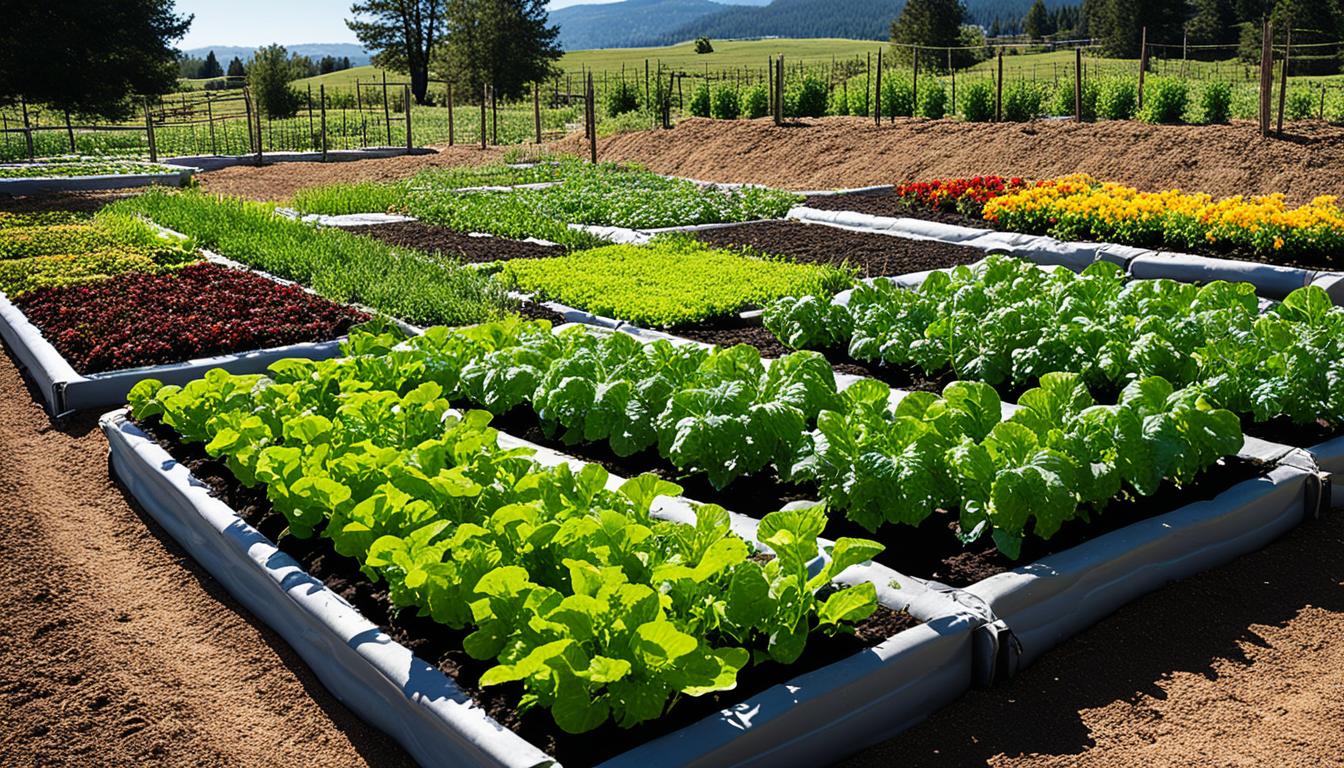
I often think about how our food and nature connect deeply. Picture yourself in a farm where everything helps each other grow. From small microorganisms in the soil to various plants, all work together. This model of farming is a must to keep our food and planet safe.
Agricultural studies have shown that biodiversity is key. Imagine learning from ancient Andean farms to modern genetic research. This journey has taught us vital ways to protect nature. But, there’s more to do. We need better ways to talk, teach, and use new farming technologies. Combined, these can make our farms richer in nature and stronger for the future.
Biodiversity in agriculture is key for sustainability. It shows us how farming, ecosystems, and economies connect. Understanding this helps us make agricultural practices better and friendlier to the environment.
Biodiversity has many environmental benefits, crucial for keeping our planet healthy. It helps restore wetlands, vital for sucking up carbon. Also, it keeps pest numbers down through diverse crops, making farms more resilient against invaders.
This is very important as invasive species threaten local wildlife worldwide. By having a variety of plants, we protect our environment.
Looking at economic sustainability, keeping biodiversity is also vital. Having many types of crops helps because only a few make up most of what we eat. This makes our food supply more stable. It means if one crop fails, others can still grow.
Focusing on variety rather than just a few types of plants makes our farms more resilient. Also, using technology helps ensure agriculture stays profitable in the long run.
| Region | Biodiversity Loss (%) | Main Causes |
|---|---|---|
| Latin America & Caribbean | 70% | Deforestation, agricultural expansion |
| United States | 70% | Grassland conversion, chemical use |
The social impacts of biodiversity are huge. It’s vital for food security and enriches our lives with beauty and culture. For example, losing prairies in the US affects local people and their way of life.
Also, fewer pollinators, like a 70% drop in monarch butterflies, affect the food we eat. It can make farming harder and food less available. So, protecting biodiversity is important for many reasons.
Managing farm biodiversity well is complex. It involves using strategies to protect and improve natural variety on farms. Good communication is key. It helps share clear messages and get everyone working together. This can really change how people think and act towards looking after biodiversity on farms. Knowing how to keep wildlife habitats safe is also very important.
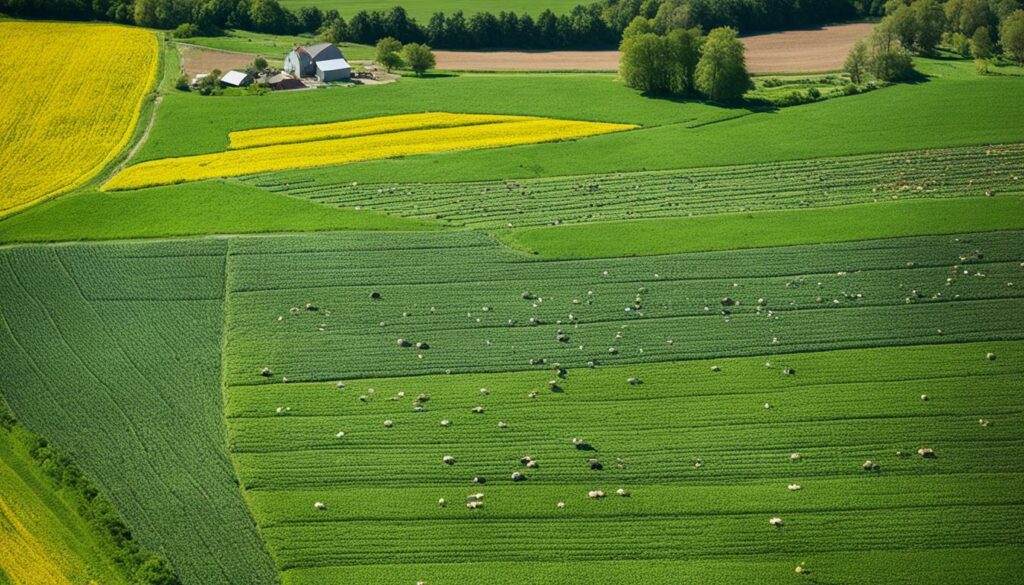
Getting advice on sustainable farming is really important. Studies show that advice can help farmers use better practices. These practices help the farm grow in a way that is good for the environment. For example, schemes that help farmers protect the environment. Researchers have found that they do help, though more work is needed in Europe to see big changes on farms.
Planting crops that come back every year can be a smart move. These plants give bugs a place to live that helps control pests naturally. They also need less chemical support. This means less pollution. This is good for nearby rivers and lakes. Plus, having different types of plants can make sure we keep getting enough food. It keeps the land healthy in different types of weather.
Getting the right messages across about biodiversity is crucial. Studies have shown that talking about solutions and working together is best. This approach can bring positive changes on farms. Bringing farmers together to talk can really help. It makes them think about their own actions and how they can do better.
Having good ways to share information can make a big difference. It’s not just about facts. Getting people to care is also key. Making them feel something about the environment can make these new ways stick. This all helps in making farms more varied and better for wildlife.
The world’s need to feed more people and boost farming challenges us to find new answers. Using rhizomicrobiomes to control diseases in farming is a big step forward. These are tiny, helpful organisms living near plant roots in the soil. They’ve been shown to help plants stay healthy and fight off diseases, changing the game for sustainable farming.
Research shows that friendly bacteria are great at making plants grow better and stopping diseases. For example, certain bacteria from the Pseudomonas syringae group have helped study new ways to make plants stronger. These bacteria work with plants to create substances that keep pests away and help the plants grow.
Using rhizomicrobiomes in farming could replace some chemical methods with natural ones. More and more, countries are using less chemical fertiliser and more bio products. This change shows that using these natural methods can grow even more. It hints at a future where these are the main tools in farming.
| Statistic | Details |
|---|---|
| Farm Output Increase | Between 1960 and 2015, farm output increased threefold. |
| CH4 and N2O Emissions | Agriculture contributes 47% of total anthropogenic CH4 emissions and 58% of N2O emissions. |
| Nanotechnology Advancements | Nanotechnology applications in plant growth and crop protection increased crop yields by 30% in 2023. |
| Effectiveness of Nanopesticides | Nanopesticides using bionanotechnology showed a 35% effectiveness rate in crop protection systems. |
| Yield Improvements | The green biosynthesis of nanoparticles led to a 15% increase in crop yields. |
Crop rotation is key in sustainable farming. It boosts soil health and biodiversity. By changing the crops grown, farmers manage nutrients better, up yields, and stop pests.
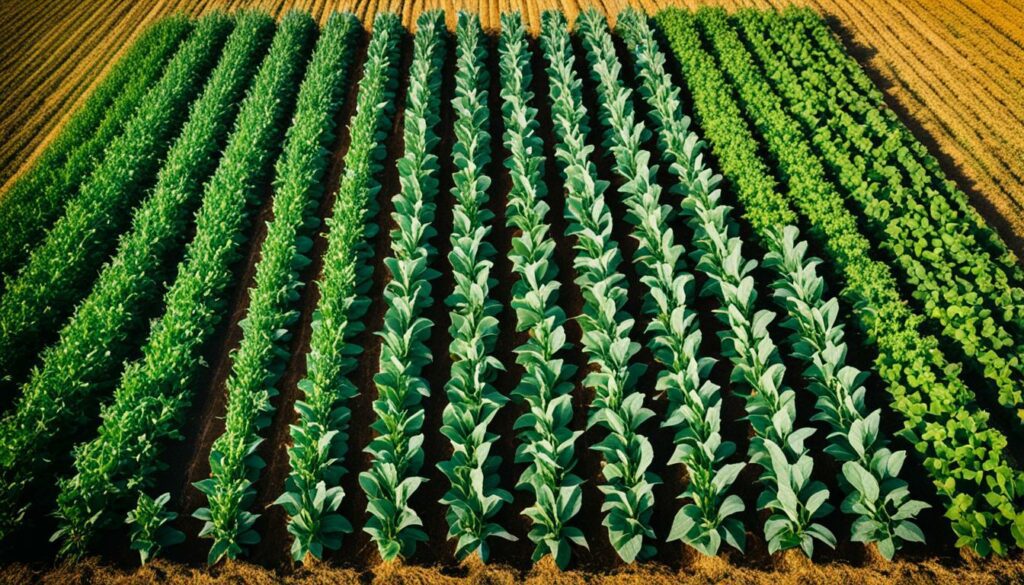
Experts say rotating various crops, like alfalfa and grains, improves soil. This is backed by studies. Diverse crops improve sustainable farming. My own observations point to healthy soils when using living roots, like cover and winter crops.
| Benefits | Impact |
|---|---|
| Disease Prevention | Reduces the risk of soil-borne diseases and pests. |
| Improved Soil Health | Enhances soil structure and nutrient distribution. |
| Reduced Input Costs | Minimizes the need for synthetic inputs and reduces animal feed costs. |
| Biodiversity Enhancement | Attracts beneficial organisms and improves habitat for insects and wildlife. |
| Economic Viability | Ensures the process is economically feasible for farmers. |
Not every farm can grow wheat. But, crops like rapeseed can replace wheat well. It’s key that these changes are good for both the land and the pocket. Growing different crops should pay off. And, policies must support such healthy farming.
Implementing *effective* crop rotation practices involve:
Sustainable techniques like crop rotation help against pests and diseases. They not only better soil and control pests but also draw in helpful creatures. This leads to richer biodiversity on farms.
Keeping wildlife habitats on farms helps keep the planet rich in life. In the UK, about 75% of the land is used for farming. So, it’s very important to use good plans to protect nature. This helps keep farms running well now and in the future.
To save wildlife on farms, it’s smart to keep the plants that belong there. Making small spots for animals also helps a lot. These steps can make crops like wheat and beans grow better, up to 8% more. They also help clean up water and stop floods, making nature healthier again.
Having wild areas on farms really boosts the different plants and animals found there. This is true no matter how the farm is run. Adding many kinds of plants to fields works better than working the land a lot. Farming with less chemicals can help nature and wildlife a lot. For example, RSPB Hope Farm in Cambridgeshire is making this happen on a big scale.
Bees and other pollinators like hoverflies are key for farms. They help crops grow just by moving pollen for free. Farmers are key to protecting places where animals live, like water voles and the rare Cirl Bunting bird.
Keeping soil healthy is key to making farms sustainable. Every year, around 24 billion metric tons of soil wash away because of erosion. This shows how important it is to protect the soil. About 30% of the world’s soils are in bad shape, risking the UN’s development goals.
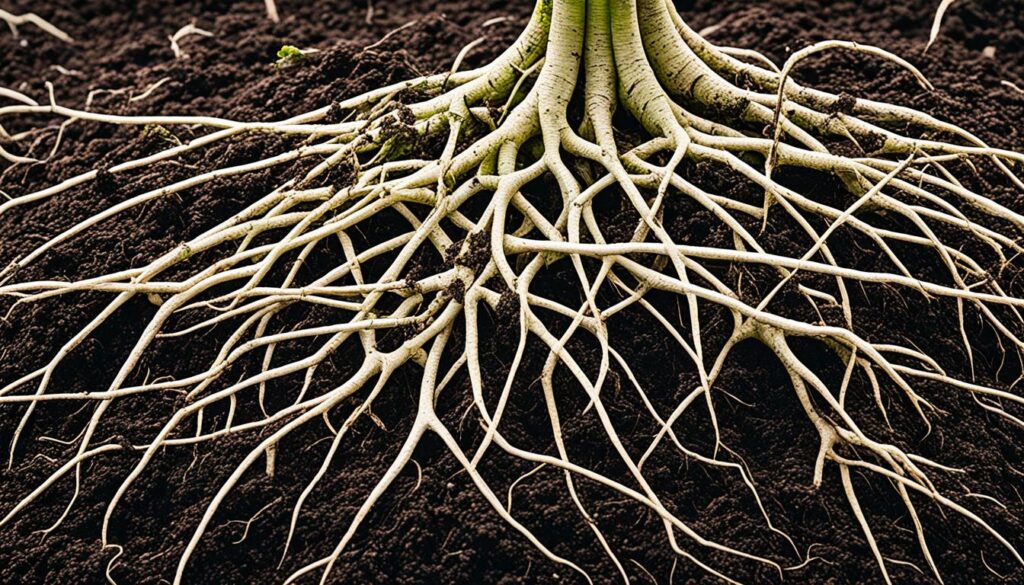
Healthy soil with many living things is vital for good farming. It helps reduce diseases in crops and pests. This effort is critical in fighting poverty and ending hunger.
A good amount of China’s and the world’s soils meet high quality marks. This proves keeping soil rich and varied is crucial. Richer soil can help with UN goals on zero hunger, good health, clean water, responsible consumption, and climate action.
To keep soil in top shape, we need to do certain things:
By using these methods, we can help our farms and environment. More and more people are going hungry, and less money is going into farming. Protecting soil is vital for a future where we can still grow enough food.
The move towards sustainable farming benefits greatly from new crops. Thanks to genomic advancements, crops like the winged bean show us a new path.
Studying plant genetics boosts our ability to improve crops. This helps us make plants that handle tough weather and bugs better. With a warming planet, much wildlife could lose their homes. Growing tough crops helps farms stay strong against these changes.
These new crops aren’t just strong; they’re full of nutrients too. They can help fight hunger by providing more food where it’s needed. A lot of animals have less space to live now compared to 50 years ago. We must change how we grow food to help save them.
Using these innovative crops is key for farming that lasts. They mix tech with nature to make our farms stronger. This way, we protect wildlife, keep our food supplies safe, and fight challenges ahead.
Integrated pest management (IPM) helps control pests on farms sustainably. It does this by using less chemical pesticides. This creates a healthier ecosystem where beneficial insects can thrive and help crops grow.
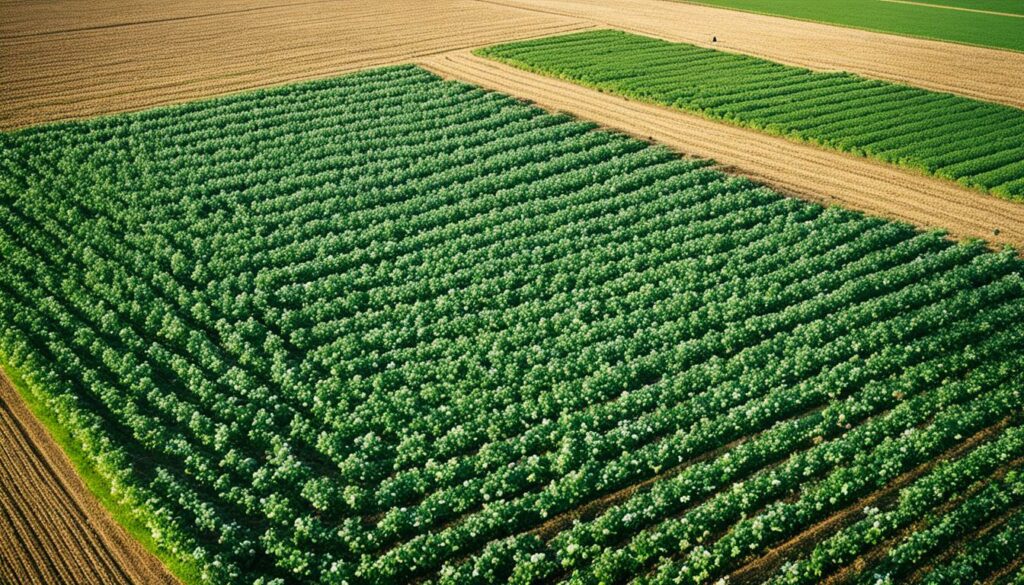
“Human behaviours are primarily responsible for driving declines in insect and avian populations,” a fact that underscores the importance of transitioning towards more sustainable pest control methods.
An important part of IPM is planting native wildflowers on the edges of fields. These flowers attract good insects and bees, which improves the farm’s variety of species. Ladybugs, for example, can help plants without causing damage.
Choosing IPM can make a big difference in helping endangered insect species. It fights against habitat loss and the overuse of pesticides. By doing this, it protects insects vital for pollination and controlling pests.
Simple steps, like planting native grasses and flowers, can significantly boost biodiversity. Initiatives like “Corners for Wildlife” have been very successful. They create areas that support many different plants and animals.
IPM doesn’t just deal with pests and diseases; it also helps the whole ecosystem. For example, it can control tick populations and prevent algae in ponds. This shows how IPM works in many ways to keep farms and their surroundings healthy.
Adding trees to farms through agroforestry brings many benefits besides looking nice. It’s being seen as key for saving species and keeping our economy strong. It helps reduce the loss of species and protects those in danger, which is important for our planet.
Adding trees to farms makes them more than just fields. The EU Green Deal loves the many benefits this brings. By using models, we see how adding trees to farms affects wildlife in interesting ways.
Agroforestry helps the planet and our wallets. It’s been shown to make farms better at stopping erosion and keeping water clean. In fact, agroforestry areas can support 60% more different types of plants and animals than regular forests.
| Type of Landscape | Biodiversity Impact |
|---|---|
| Agroforestry | Higher species richness and ecological services |
| Agriculture | Moderate species richness, varies with practices |
| Forest | High species diversity if undisturbed |
Not only that, but it gives farmers different ways to make money, like selling fruits or timber. In Brittany, France, 20% of farmers use hedgerows. This adds to the income and helps nature. Using agroforestry can also make farms more productive without harming the environment.
Organic farming is seen as an eco-friendly way to grow food. It focuses on saving wildlife and using farming methods that last long. These ways are made to keep the natural balance, help the soil stay healthy, and lessen the need for fake chemicals.
It’s all about caring for our land and water. People that grow organic crops and raise animals follow strict rules. They use only things that are good for the earth and water. This includes planting local wild plants to help insects and birds thrive. This method stops soil from washing away, helps keep water clean, and fights pollution.
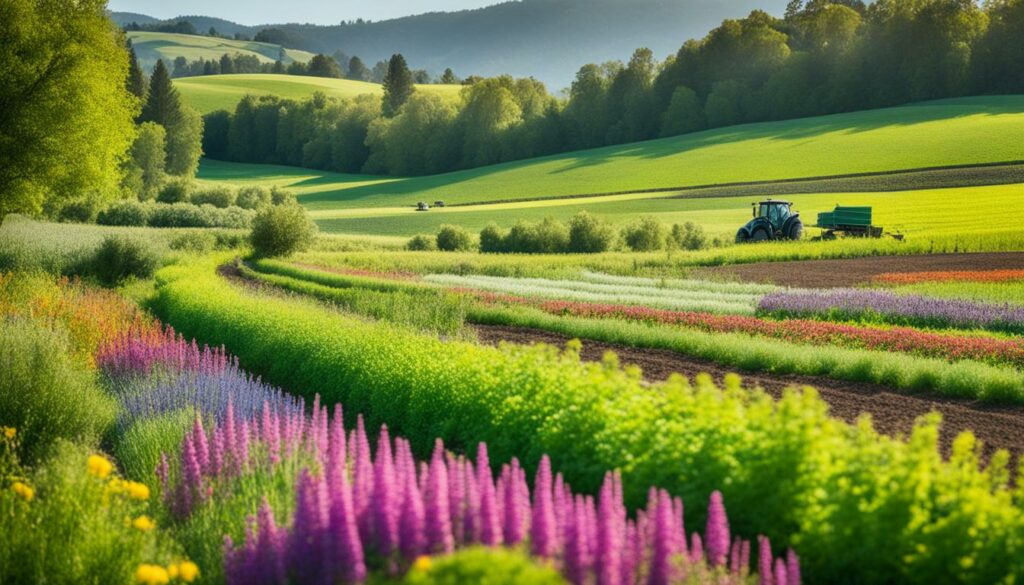
Organic farming does a lot to keep the world’s wildlife happy. It makes a home for good bugs and helps birds and animals live well. By keeping animals away from important water areas, water stays clean and animals have a good place to live. Organically grown plants also deal better with dry weather, get pollinated more, and need less care against bad insects. This all helps keep our water and nature healthy.
| Year | Net Income (HOF) |
|---|---|
| 2007 | $24,423 |
| 2014 | $258,827 |
The National Organic Program (NOP) checks that organic farms are doing things right. For example, the net income of Hongyi Organic Farm (HOF) jumped from $24,423 in 2007 to $258,827 in 2014. The big change came after they used special methods that help crops grow more over eight years.
These facts show how well organic farming works for nature and farming. It proves that we can grow food without harming nature. Organic farming is a great example of helping nature and farming go hand in hand.
Herbicide pollution is a big worry for biodiversity, especially in the sea. Flying insects have dropped over 75 percent in numbers in the past 30 years. This drop shows how chemicals in farming affect a wide area.
Herbicides and pesticides reach water, hurting the bug variety. Fungicides like Probenazole lower the fish types you see. They also harm bees and other life over time.
Insecticides like BPMC cut the numbers of large bugs by up to 77%. These chemicals and hard edges like concrete hurt the little guys too.
Nearly 6% of known species live in fresh water, along with a third of all backboned animals. But, it’s only a small part of the world. The effect on non-target life from these toxins is huge, damaging variety greatly.
We need to act quickly against herbicide harm. Better rules and checks on pesticide use are key. In Europe, pesticide approval doesn’t always keep nature safe.
Using safer pest controls and protecting natural areas help a lot. For instance, in Japan, irrigation ponds help keep life rich. This can protect against some harmful effects.
When we can’t stop all herbicide harm, we can lower it. Using natural ways to clean up and planting filters near water are good choices. Teaching farmers better ways and reminding everyone to be careful are vital too.
Renewable energy is vital for sustainable farming. It’s because agriculture uses much of the world’s energy. Switching to renewable energy helps cut down on harmful emissions. This change makes food more available, and energy more stable and affordable. by using solar power that’s friendly to nature and placing solar panels on farm lands, we can have a greener agriculture future.
Renewable energy boosts food security in a big way. Studies show that planting solar panels near fields can attract more bees. This leads to better crop growth. Also, using solar panels over farms improves the land for plants and animals, helping the environment and crop production. 
Green energy methods save money and make farms more independent. They create stable systems for producing food for the long run. By using less fossil fuels, farms can do better in changing energy markets. This means they can keep producing food even when things are uncertain.
South Asia has great examples of how solar energy helps farms. In just five years, the number of insects around solar panels tripled. Native bees increased by 20 times in these areas. This proves that solar farms can improve how much food we grow while helping the environment.
Although renewable energy brings many benefits to farming, it doesn’t get enough funding for research. This lack of support slows down the creation of new farming solutions. To solve this, we need more money and experts from different fields to work together.
Using renewable energy in farming, like sun, wind, and biofuels, is great for the future. There are government schemes that help farmers use these cleaner ways. These support programmes, along with local and national help, make it easier for farmers to switch to green energy. They also help in growing these methods as farmers need more power in the future.
Farmer discussion groups are now key in helping farmers improve and change their practices. They create a space where farmers can share their stories and learn from each other about managing biodiversity.
In a study of six Irish dairy farmer groups, researchers looked at how knowledge and attitudes changed. Both baseline and follow-up surveys showed a big improvement in how farmers saw farmland biodiversity. The way these groups talked to farmers helped a lot.
After joining, farmers began to see the value of managing biodiversity. Their attitudes changed for the better.
Each farmer group usually has 12 to 15 members. These farmers run similar businesses. This setting is perfect for sharing learning and support. By talking and planning together, these groups inspire change in how farming is done.
They push for adding biodiversity protection to farming goals. This means farmers start thinking and acting in ways that are better for nature long-term.
Training programmes also greatly boost farmers’ knowledge about biodiversity and how to protect it. This leads to stronger management of biodiversity in the fields.
Communication campaigns are key—these involve training early adopter farmers to demonstrate sustainable practices, use simple language, and share achievements with peers. Such initiatives have led to increased conservation efforts and dedicated time for biodiversity protection.
Good laws, rules, and rewards are also very important in helping farmers make changes that help biodiversity. These are especially needed in places where farming is really common. The study shows that having set plans can work better than just asking farmers to volunteer.
Overall, these farmer groups are doing a great job in teaching farmers and getting them to change how they farm for the better. I truly believe we should keep supporting and growing these groups. This way, they can have even more impact on how farms protect nature.
Unveiling the past through varied research methodologies provides a wealth of knowledge on historical insights on cultivation in the Andean region. These insights, derived from rigorous isotope analysis, have amplified our understanding of ancient agricultural practices.
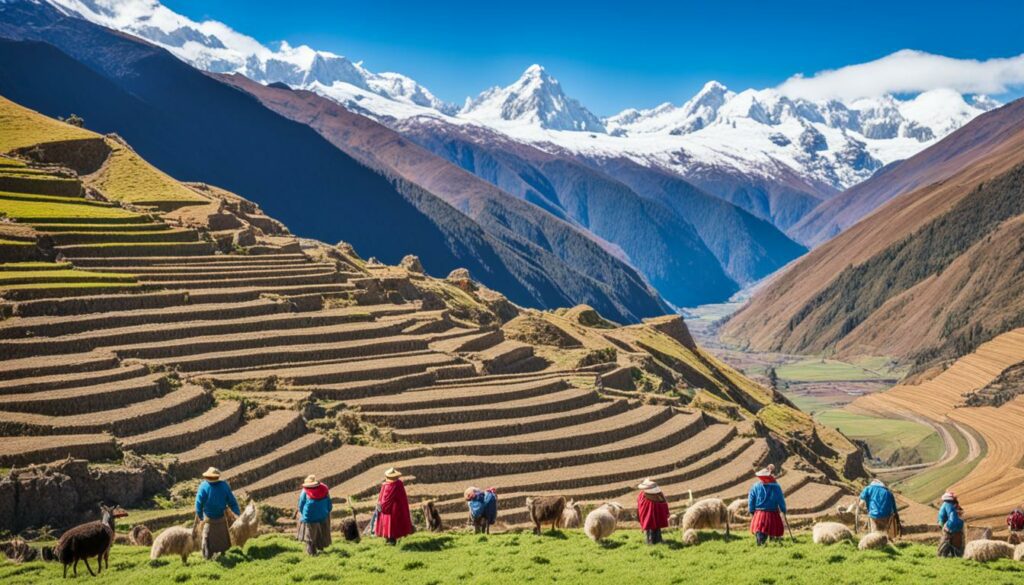
The meticulous isotope analysis in agriculture is instrumental in tracing the origins and progress of domestication processes. Evidently, the domestication of plants and animals took hundreds of years and involved significant environmental modifications. A crucial revelation was how Andean agricultural practices remained resilient amid geological and climatic disruptions.
Andean societies gathered sustenance through an amalgamation of indigenous crops and those borrowed from elsewhere. Tools such as the chaquitaqlla and various sticks for digging and planting reflect their ingenuity. Additionally, camelid dung’s use as a fertiliser and fuel showcases their efficient resource utilisation.
Modern sustainable farming can draw substantial lessons from these historical insights on cultivation. The community-centric approach, as exemplified by the ayllu unit, underscores the importance of collective effort in agricultural success. Current practices can also benefit from adopting short fallow periods and leveraging organic fertilisers, akin to those used in traditional Andean agricultural practices.
The Andean farmers’ ability to produce surpluses further contradicts the perception that historical agriculture was solely subsistence-based. By building on these insights, modern agricultural techniques can enhance resilience and productivity while maintaining biodiversity.
The world’s people have grown from 2.5 billion to 8 billion in seventy years. This has affected our planet’s variety of life, or biodiversity, a lot. Geopolitical conflicts, like the war between Russia and Ukraine, make these issues worse. Such conflicts result in the loss of different plant and animal species. They also cause more land worldwide to be used for growing crops.
The conflict between Russia and Ukraine greatly affected the amount of grain grown. Ukraine, a big grain producer, saw nearly 29% less grain due to the war. This shows how conflicts can hurt food production and the environment. Less grain means less food security and more pressure on using other lands for farming. This leads to more damage to our natural ecosystems.
The war also disrupts efforts to preserve nature. It makes it harder for countries to protect their wildlife and natural spaces. When resources are used to fight wars, less is left to keep our environments safe. This shows how war can set off a chain reaction that hurts both wildlife and the services nature provides us.
More food is needed because the world’s population is growing, but wars and conflicts make it harder to farm. This extra farming often means destroying natural habitats where wildlife live. About three-quarters of the world’s lands that are not covered in ice have been majorly changed by people. Unfortunately, this damage is expected to continue.
Solving the problem of wars’ impact on nature needs a joint effort. This must consider how our changing climate affects the land. The plan should bring together farming, diplomacy, and defence activities. For example, expanding farm areas ruins places where various plants and animals live. As a result, over a million of them could soon disappear forever.
| Aspect | Current Statistics | Projected Impact |
|---|---|---|
| Global Population Growth | 2.5 billion to 8 billion in 70 years | Increased pressure on food production and biodiversity |
| CO2 Emissions | Need to decrease by 45% by 2030 | Risk of temperature rise by 2.8°C |
| Terrestrial Surface Altered | Three-quarters of ice-free surfaces | Further degradation of natural habitats |
| Marine Environment | Two-thirds significantly altered | Decline in marine biodiversity |
In summary, the link between wars and nature’s variety is very complicated. We need strong actions to lessen these problems and help ecosystems bounce back. This way, we can save different plants and animals for the people who come after us.
By 2050, the world will likely have over nine billion people. This growth poses big challenges for our food supply. Edible insects could be an important part of the solution. They provide many benefits for our planet.
Edible insects have several key advantages. They are remarkably efficient at turning plant proteins into edible proteins. For example, it takes less than 2 kg of food to grow a kg of cricket. In comparison, it takes 2.5 kg for a chicken, 5 kg for a pig, and up to 10 kg for cattle. Crickets are also much more edible, up to 80%, while pigs and chickens are only about 55% and cattle as low as 40%.
Besides, eating insects is good for the planet. The meat industry contributes about 18% of the world’s greenhouse gases. This is more than all cars and planes. In contrast, insects produce far less greenhouse gases and ammonia. These benefits make insects a sustainable option to feed the growing population.
Adding edible insects to our meals can improve how sustainable we are. Over two billion people already eat insects as part of their daily food. This shows that making insects more popular worldwide is very possible.
Insects are becoming more important as we try to support our food systems. By 2050, we’ll need 72% more meat. Insects can meet this demand without harming the environment as much. They are a great choice for the future of food.
| Feed (kg) per kg Gain | Edible Percentage | Greenhouse Gas Emissions | |
|---|---|---|---|
| Crickets | 80% | Lower by 100x per kg compared to cattle | |
| Chickens | 2.5 | 55% | Higher |
| Pigs | 5 | 55% | Higher |
| Cattle | Up to 10 | 40% | Highest |
The research highlighted in this article shows how sustainable farming can change the game. We’ve seen the positive impact from farms in Ireland learning together to the change in behavior due to regulations aimed at helping nature. It all points to a future where farms are both good for nature and profitable.
Projects that teach farmers new ways, like those in Switzerland, are crucial. They show big benefits from sharing knowledge. In the USA, projects such as “Cover Crop Champions” make it clear that focusing on special messages can make farmers choose more eco-friendly ways to farm.
The numbers prove we must act fast: one-third of our land is farmed, and the pollution hurts our planet. By farming in ways that care for nature and thinking about biodiversity in daily farm work, we can help secure our food future and protect the environment. This will keep our planet safe for those coming after us.
Sustainable farming helps the planet in many ways. It keeps different plants and animals alive, saves our land and water, and helps farmers make money while taking care of our home.
Farmers use smart ways to grow many crops without harming the environment. This includes changing which crops they plant in each field, not using too many chemicals, and making sure animals have safe spaces to live. These actions make nature healthier.
Mixing different plants and animals on farms makes nature stronger. It keeps the soil full of nutrients, cleans the water, and helps nature deal with problems like too much heat or rain.
Good, alive soil is key to growing strong crops without needing lots of chemicals. It helps plants get the food they need, keeps the soil ready to grow food year after year, and stops harmful bugs and sicknesses.
Switching crops around fields keeps the soil healthy and the plants safe. It also uses the land better, keeps the soil rich, and stops sicknesses from ruining the crops. This way, there’s more food and a richer living space for nature.
It’s important to let nature grow and move the way it wants. This means keeping natural areas, connecting them so animals can travel, and not using chemicals that hurt birds and bugs. These help to protect our wild friends.
Organic farmers treat the earth like a living thing, not like a factory. They use less fake stuff and more natural ways to help plants grow, which makes the farm and the nature around it stronger and safer for all creatures.
These tiny helpers live near plant roots and keep them safe. They help plants fight sickness and grow bigger, needing fewer chemicals. This means farms stay healthy and safe for the long term.
World arguments often take up more land for farming, making it hard for animals and plants to live. We need to work together to protect our shared world from losing its rich variety of life.
Big trees among crops make farms better for nature and for farmers. They protect the soil, give animals homes, and bring in money in different ways. It’s a win-win for everyone and the planet.
Farmers learning from each other helps nature and their farms. Talking about what works to keep a farm healthy and profitable without hurting the environment is the best way forward.
Old ways of farming in the Andes show us we can feed everyone without harming the earth. By growing many different crops and protecting natural spaces, we can learn to live in harmony with nature.
Using clean energy from the sun and the wind is good for everyone. It means less pollution, more secure energy, and better ways to farm that protect the earth and the people who live on it.
Eating bugs is good for us and the earth. They are very healthy and need much less space and water than other foods. This makes them a great choice for feeding people without hurting the planet.
Too many weed killers can hurt the land and the water where animals live. It’s important to find ways to grow food without these harmful chemicals to keep our nature safe and diverse.